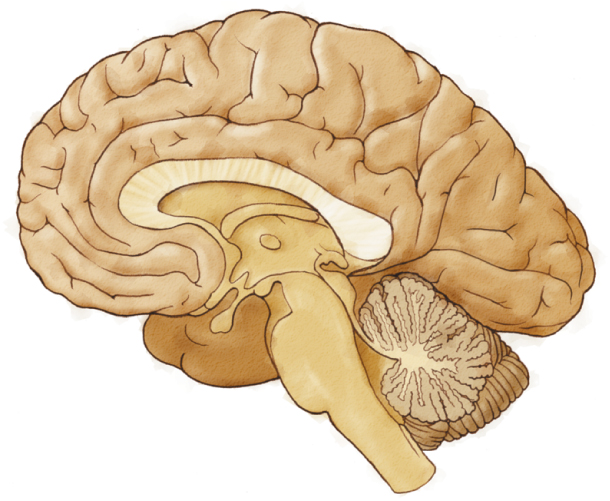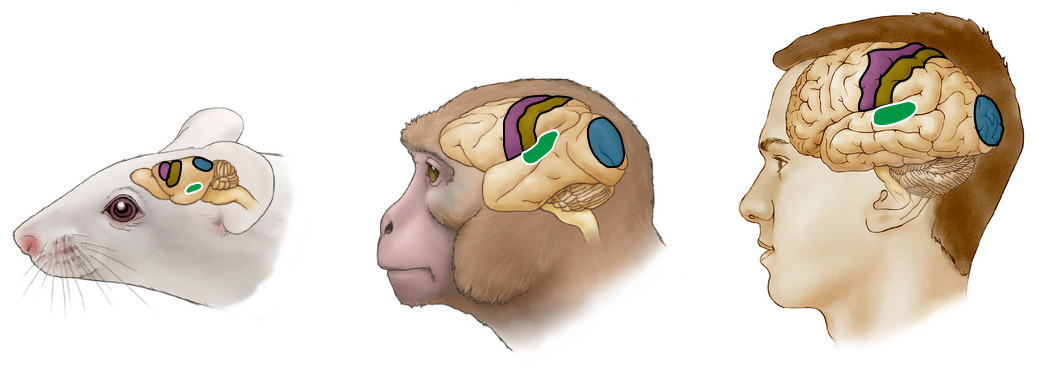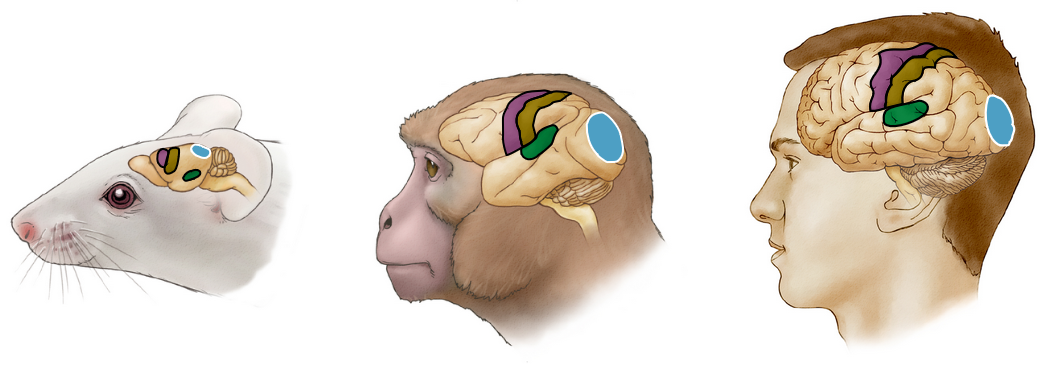Chapter 1. Evolution of Brains and Behavior
1.0.1 Evolution of Brains and Behavior
Evolution of Brains and Behavior
By: Dr. Daniel Hummer, Morehouse College
1.1 Introduction
In this activity, you will learn how specific brain and nervous system structures evolved to regulate similar behavioral functions in various animals, including humans.
After completing this activity, you should be able to:
- Describe major similarities in brain structure and function between animals and explain why these similarities exist
- Describe how similarities in brain structure correspond to similarities in behavior between animals
This activity relates to the following principles of nervous system function:
- Principle 1: The Nervous System Produces Movement in a Perceptual World the Brain Constructs
- Principle 7: Sensory and Motor Divisions Permeate the Nervous System
- Principle 9: Brain Functions Are Localized and Distributed
1.2 Comparative Anatomy: The Cerebellum of Vertebrates
The brains of all vertebrates evolved from a common ancestor and thus share common features. There is remarkable similarity, for example, in the structure and function of neurons across vastly different species. Parallels in brain structure, organization, and function enable researchers to use a simple systems approach to understand physiological systems.
This activity will enable you to visualize one example of a feature common to brains across numerous vertebrate species: the cerebellum. Despite considerable variation in its size and shape, there is remarkable similarity in its structure and function across vertebrate species.
1.3 Comparative Anatomy: The Cerebellum of Vertebrates
The cerebellum is a hindbrain structure common across vertebrate species. Despite differences in its size and shape, the cerebellum is involved in controlling movement, specifically the timing, coordination, and precision of movements, in a variety of vertebrate animals.
Watch the video to observe the relationship between movement and cerebellum activity.

The cerebellum is involved in controlling the timing, coordination, and precision of movements in fish, amphibians, birds, and mammals (in addition to other vertebrate animals).
1.4 Quiz: Comparative Anatomy: The Cerebellum of Vertebrates
Question 1.1
DC4jCEK/nMH1iJtLBvdfGNjk3p/+Z2q59g2Ah7yrp93vfbAscJFYRIvuRjW/3Uh0tgXCSB7bLEU4gYeHgWiIiqUEz+8Kk6zlvxstJu5XdwSgHK87+XisXPmcPcGR/fJpeo9KQNQuiE+1VMczsh7VuJEUBHs=Your answer has been provisionally accepted. You'll get full credit for now, but your instructor may update your grade later after evaluating it.
1.5 Comparative Anatomy: Organization of the Mammalian Brain
Since all mammals evolved from a common ancestor, it is no surprise that the brains of different mammalian species resemble each other, including many striking commonalities in brain organization. For example, executive functions are commonly represented in anterior (rostral) brain regions, auditory functions in lateral regions, motor functions in dorsal regions, and visual functions in posterior (caudal) brain regions.
The following activity will enable you to visualize parallels in brain organization between vastly different mammalian species.

1.6 Comparative Anatomy: Organization of the Mammalian Brain
Watch each animation below to see which areas of the mouse, macaque, and human brain are involved in processing the same action or sensation. The Continue button will appear after all 4 animations have been played.
Video Box
Tactile Stimulation:
The primary somatosensory cortex processes tactile (touch) information from the skin.

Video Box
Auditory Stimulation:
The primary auditory cortex is one of many areas in the central nervous system responsible for processing auditory (sound) information.

Video Box
Visual Stimulation:
The primary visual cortex is responsible for early stages of visual processing.

Video Box
Motor Control:
The primary motor cortex is one of many areas in the central nervous system responsible for controlling movement.

Various mammalian species exhibit remarkable similarities in the structure, function, and organization of the nervous system. Despite differences in the size and complexity of the brain, mice, macaques, and humans (among other mammals) each possess a somatosensory cortex in the dorsal brain for processing tactile stimuli, auditory cortex in the lateral brain for processing sound, a visual cortex in the posterior (caudal) brain for processing visual stimuli, and a motor cortex in the dorsal brain (anterior (rostral) to the somatosensory cortex) for generating movement.
1.7 Quiz: Comparative Anatomy: Organization of the Mammalian Brain
Question
FNFj0/2juynrCn/kUavjfymYUEgT1sb+XgzynacFgZKiDZxjdQ5l6YQAnafoONyAApsUoG4Xilpe7lrdyw0EgykPTRlU8K9TzUr7ZdnxgrZuyJ2tjU4dFVSXpkQ7Co4gkzBdBKLsBTUkYbhIvUGKz5lt0MYDhFxlX+HiQcTgPR0V/0AnimPKCAjowULK1NA2mYlNi5LC9ynIYrw8SPMmb7aGHOClOnn7aQGQql+FwE+BXKYnuqLFkst1OCE77b7KMVfEwoGiHCGpXviL2EuyIDggGwlYaIRhDK9b9uJWdktjAdIyE5LBqnoZqI/xqsXl6UcuCHdoLaDCrhvS

Question 1.2
7f1Np/txo716P9mT5IrBLEWrGdIjOSdFBMQSikwuv9WPR8w/vwNFZzi+fAMP6rFAccOxZjn3Riu9Sp1MCl/7gqKeiJHqsAvNLd6Qz7w2OnwtjTjD866HQRIXyM3Tz6g4f0YkYu0yGKsBltR55casFHbganNmubx8/Y5eAer58qGViYSI2FCwMXqqAtN9BJ0VQBQpUjss3WdsAuzYcw0wcwbGJCpL+LdX4Xw88LBuuBX5QDuX3aER00Nax0rrHgHTF8edfOjYPKtBDPDuDC5A6WVMxxjLaFWe4yNkxh3lISo=

Question
/0AqgD0rjD0P5SE6xrYMcFHJjwRoyjppCH/Ohqz8T+LlEUNQ0+9ZziVUHpvxBqc4staUWNNifoPpDwTkh1DJu+1O0jXWeN0aXPyhDLKJgd1Ioszefpm6mOv6AIJbyx92pyGQO0KP6slWyzjpEP4exbROvjj8Ud5HaQayPlRZPhDuCX8fATU03SuhnnJ+aXpgvcacdtTI/yHntDTc5omh8U2LFqYqPD1Ja7VGDzfwwESp4jtNrd09QgUB42yviseUAUnVvI16VmSl9Plw4jVwjX8SUMl9THBtFCRQdA==

Question 1.3
SK6HZ71C4BPOC46Vtt2WWx3Q3gbnRnFJAP6oEnRUlDC4qN1KDnHF6e48T6z/fdbDO6bvex4qZCDsez5BzTd0lawGkJSYEim+qd78ly1A2PQshtCWpBvovgLkIrba0doXoXsGgUs6puNAmcYtdSMiBlGAtB7EyjfMFXzm7iDMLfuozZ2bZHqJ5b50eCjO6t1TknFBpegUWSrP0nKbVbUX0+IzqwY7mCk0tJ7irgNDER/WmCwdh8SheZS7VSvXopeGq1QMT47YEeL4GCxqYz3G+kKMhIjpxyQw

1.8 Summary
Congratulations! You successfully completed the Evolution of Brains and Behavior activity. In this activity, you compared the brain anatomy of various animals and learned that similar brain structures evolved to regulate similar behavioral functions in vastly different species.
Your instructor may now have you take a short quiz about this activity. Good luck!